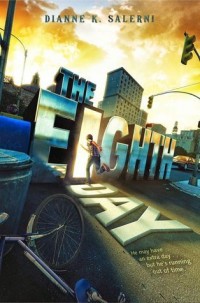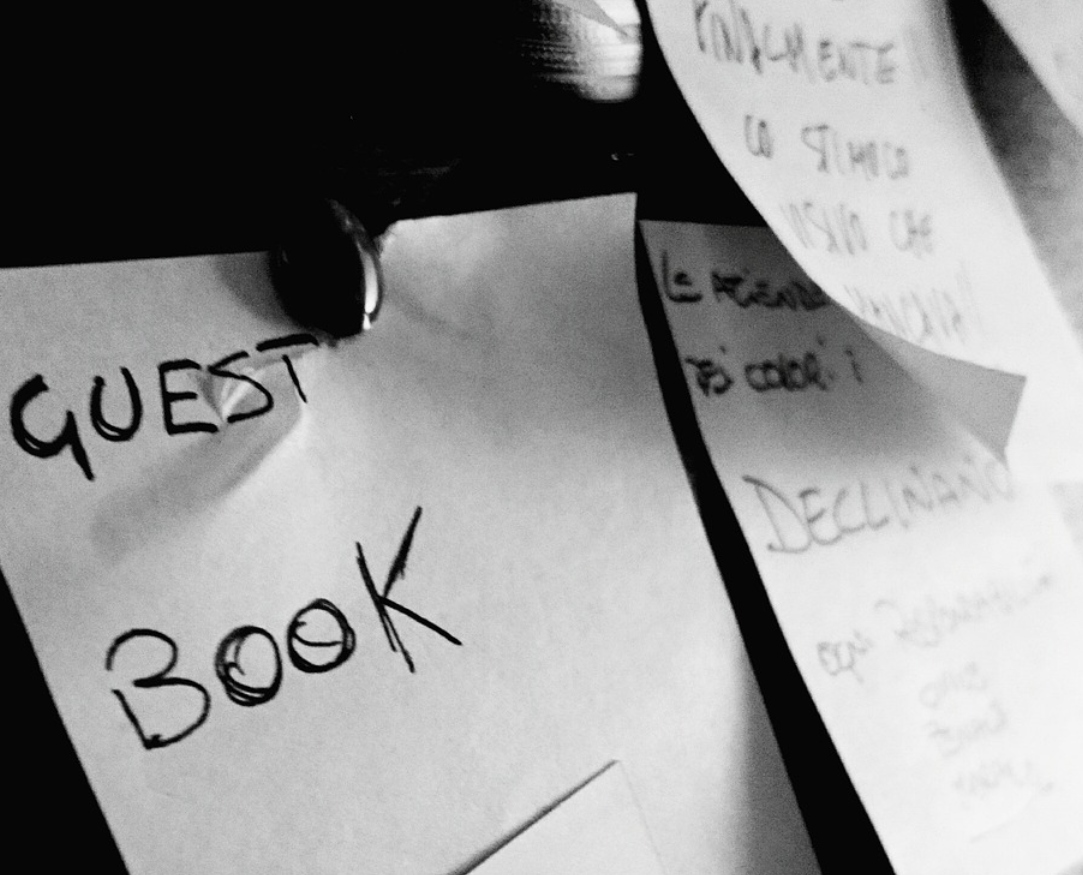What to Do with a Franken-Draft
By Guest | April 20, 2014 |
Please welcome today’s guest, Dianne K. Salerni, fifth-grade teacher and author of a magical “fast-paced and exciting” (Library Journal) story for 8-to-12-year-olds called The Eighth Day, a “promising start to a new trilogy” (Kirkus).
What’s the book about?
When newly orphaned Jax Aubrey awakes to a world without people the day after his thirteenth birthday, he thinks it’s the apocalypse. But then the next day is a regular old Thursday. Has Jax gone crazy? What’s going on?
Riley Pendare, Jax’s sort of clueless eighteen-year-old guardian, breaks the news: Jax just experienced the Eighth Day, an extra twenty-four-hour period between Wednesday and Thursday. Some people, like Jax and Riley, have the ability to live in all eight days. But others, like Evangeline, the teenage girl who’s been hiding in the house next door for years, exist only on this special day.
At first it’s awesome to have a secret day. But as Jax gets to know the very guarded Evangeline, he discovers that she is the sought-after key to an ancient spell rooted in Arthurian legend. And Riley—who forgets to pay bills and buy groceries!—is sworn to keep her safe from those who want to use her to eliminate the seven-day world and all who live there.
Jax tries to protect Evangeline, but with his new friend’s life on the line, as well as the threat of human destruction, he is faced with an impossible choice: trigger a real apocalypse or sacrifice Evangeline.
With a whole extra day to figure things out, it couldn’t be too hard . . . right?
You can learn more about Dianne and The Eighth Day on her website and blog, and follow her on Facebook and Twitter.
What to Do with a Franken-Draft
So, you’ve written a huge, rambling monster of a first draft—something so mangled and ridden with plot holes you aren’t sure it can be saved. I’ve certainly done it, and since I write “fat,” my monster usually has a ridiculous word count, too (like 100k for a middle grade novel). You might be tempted to grab a shovel, bash the thing over its head, and bury it.
Don’t. You can save Franken-draft.
The first thing I suggest is outlining your book. Yes, outline it after you’ve written it and even if you had an outline before you started writing the thing. You may have had a plan, but what did you actually put into the manuscript? A simple two-column table in a Word document works for me. I use the left-hand column to summarize the events in each chapter. The right-hand column is for recording changes I need to make.
To help guide my revision choices, I also use a separate color-coded outline to analyze the pacing and how various subplots are woven into the story. Again, I work chapter-by-chapter, boiling the events down to one or two sentences, summarizing the contents of each one. In this example, I assigned purple to the central mystery, blue to a secondary mystery, and yellow to the romantic subplot. The color-highlighting helps me see where the various plot elements appear and make sure that one doesn’t disappear for too long, or that the romance doesn’t overwhelm the main story line. I can now spot what needs to be cut and rearranged in my monster.
As for the actual revising, I prefer to make several successive passes through a manuscript rather than try to perfect the story in the second draft. I find this makes it easier for me to kill my darlings. In my second time through the manuscript, I might say, “Noooo, I can’t let that go. I loooove it.” However, by the time I’m running through the manuscript on pass #5, I’m far less attached to those darlings and I can cut them with a “Meh. Not as cute as I thought.”
 As for word slashing, put on your Grim Reaper robe, grab a scythe, and get ruthless. Most of the time, you can remove just, even, and very without changing the meaning of your sentence. People can stand and sit instead of stand up and sit down. They nod and wave. (No need to say which body part is getting nodded or waved. We know.) Avoid phrases with multiple prepositions. In the back of becomes behind, and on the top of can often be reduced to on. I have a bad habit of identifying characters by their first and last names when one or the other will do. I also use multiple adjectives when a single precise one would be more effective.
As for word slashing, put on your Grim Reaper robe, grab a scythe, and get ruthless. Most of the time, you can remove just, even, and very without changing the meaning of your sentence. People can stand and sit instead of stand up and sit down. They nod and wave. (No need to say which body part is getting nodded or waved. We know.) Avoid phrases with multiple prepositions. In the back of becomes behind, and on the top of can often be reduced to on. I have a bad habit of identifying characters by their first and last names when one or the other will do. I also use multiple adjectives when a single precise one would be more effective.
And that sentence or paragraph? You know the one I mean. The one you can’t get right no matter how many times you revise it. Try cutting it entirely and replacing it with nothing. If it was that hard to say, maybe it doesn’t need to be said.
By now, hopefully, Franken-draft has been civilized a little bit and is ready to bring out in society, or at least shared with beta readers.
Have you tackled a Franken-draft? What did you do to tame your beast? We’d love to hear about it in comments.











I have nothing to add or subtract for todays lesson. Okay, I will add a “hear, hear” to outlining after your first draft.
My question is, which one of you invited Dianne K. Salerni. Huh! huh!
I have over sixty books I need to read. COME ON PEOPLE!!!!!!
Bahhh! I am so loving Dianne’s voice right now. Can you hear it? It’s like cruising down the highway in a luxury vehicle, but unaware you’re traveling 100 miles hours towards deadman’s curve. EXCITING!!!!!!
Smooth, fast pace with an expectation of chaos
How does she keep all that energy contained?
Oh, never mind, she’s a fifth grade teacher.
Oh, outline AFTER the story is all out? Wow, never thought of that approach. Sometimes I’ll do a rough plot sketch of what happens, when, and why to be sure I’ve been as cohesive and concise as possible but I think your idea of doing a complete outline is a good one. Thanks, Dianne.
“As for the actual revising, I prefer to make several successive passes through a manuscript rather than try to perfect the story in the second draft.” I agree, although I find the second pass is the most crucial because, if the story can’t be fixed there, you may have to abandon it. I never thought of outling after the first draft is completed, but it seems suited to my ‘pantser’ proclivities. Your outlining system is clear and understandable. I always learn from reading about the writing process from different perspectives. Thanks, Dianne, for sharing your process with the WU community.
It sounds like great fun to go off on an adventure like that – not knowing exactly how you’re going to arrive at the end of the journey.
Like helicopter skiing.
Just because some of us are extreme plotters and literally can’t do that doesn’t mean those who can are doing anything wrong – it just means every writer is different, and we can all learn from each other, even if it is only by recoiling in horror.
The best writing advice, the ONLY writing advice, that works is: try anything that sounds as if it might work for you – keep what actually DOES work for you. And be willing to try new things even after you’ve settled into your own process. Especially if your process gets stuck regularly.
Who knows? You might be pleasantly surprised.
You made your way sound like a lot of fun. So does bungie jumping.
Ooo Bungie jumping, come on Alicia you know you wanna.
My orthopedic surgeon would have a fit!
But go right ahead – people with that much energy have to use it up somehow. It’s hard to sit still and write.
I found this to be an most interesting and helpful piece. I pinned it on Pinterest as suggested above. Thank you for sharing this information.
Am I the only one who couldn’t focus on the lesson because of how awesome that book sounded?
You are not alone, Anastasia. I had to read it twice.
That book IS awesome! I was privileged to read THE EIGHTH DAY in ARC form. And the story more than lives up to its premise.
Dianne, I’m going to have to try outlining after my rough draft. I’m a pantser and hate outlining, but I always have a second document going that I call Notes. It may be 50 pages or more, but it’s messy.
My first drafts are always too short, not too long, and then in successive drafts I have to add entire scenes and details and sensory images.
Love the suggestion of simply cutting out that horrible sentence and replacing it with nothing because maybe it didn’t need to be said! Great idea.
To this:
“Most of the time, you can remove just, even, and very without changing the meaning of your sentence.”
I’d add the word: that.
I just finished my very own Franken-draft (160K words, needs to get down to way under 100k, preferably 90k). I’ll give your ideas a try, Diane. Thanks.
Chris
What an incredible story – hard to think about the article after that. But i pushed forth. Great article. Makes me not feel so bad about my franken-draft. Thank you for this.
Thanks, everyone!
The Eighth Day really was a Franken-draft in its original form — almost 99k words and a horrible mess.
I think it ended up around 65k words in its final version, respectable for the intended audience.
If I can do it, you can do it! :D
I completed the worst rough draft in the world around Christmastime 2013, after a full year of wrestling with the writing of this novel from vague idea to Franken-draft. I was so disgusted with it that I could barely stomach the initial line editing I forced myself to do, and even reading my “favorite” sections of it made me cringe, so I threw it in a drawer and started a new story. Now, at the tail-end of April, my new WIP and I have reached an impasse. I dug Franken-draft out again, and I’m busy cutting it up, hoping desperately that the poor monster wakes up after I’m done stitching, because right now, to be honest, I’m not so sure. :P
[…] since elementary school.Thank you, everybody – to Writer Unboxed who hosted my guest post about Franken-drafts, to Michael Gittel-Gilmartin who not only gave me the release day to talk about antagonists at […]